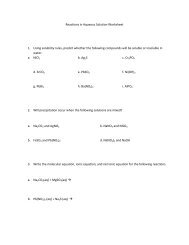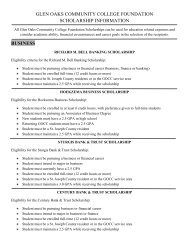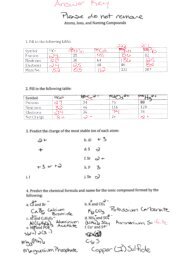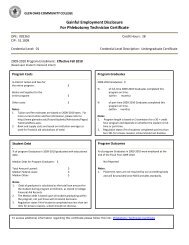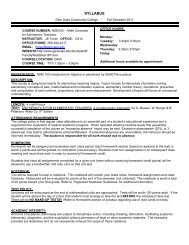NSM100 – Introduction to Algebra Chapter 5 Notes – Factoring
NSM100 – Introduction to Algebra Chapter 5 Notes – Factoring
NSM100 – Introduction to Algebra Chapter 5 Notes – Factoring
Create successful ePaper yourself
Turn your PDF publications into a flip-book with our unique Google optimized e-Paper software.
<strong>NSM100</strong> <strong>–</strong> <strong>Introduction</strong> <strong>to</strong> <strong>Algebra</strong><br />
<strong>Chapter</strong> 5 <strong>Notes</strong> <strong>–</strong> Fac<strong>to</strong>ring<br />
Section 5.1 <strong>–</strong> Greatest Common Fac<strong>to</strong>r (GCF) and Fac<strong>to</strong>ring by Grouping<br />
Greatest Common Fac<strong>to</strong>r for a polynomial is the largest monomial that divides (is a fac<strong>to</strong>r of) each<br />
term of the polynomial.<br />
− GCF is the biggest 'parts' all terms have in common<br />
Example: 4x 3 + 12x 2 ‐ For coefficients: the greatest number in common is 4<br />
‐ For x variable: the most they have in common is x 2<br />
4x 2 (x + 3)<br />
Example: 3a 3 b 2 + 9a 2 b 3 ‐ 21a 3 b ‐ Coefficients: largest common number is 3<br />
‐ a‐variable: the most they have in commong is a 2<br />
‐ b‐variable: the most they have in common is b<br />
3a 2 b(1ab + 3b 2 <strong>–</strong> 7a)<br />
** NOTE: If you pull out an entire term <strong>–</strong> must leave a 1 in its original place.<br />
Example: Find the GCF for the following polynomial:<br />
8x 4 + 2x 2 <strong>–</strong> 4x 3<br />
= 2x 2 (4x 2 + 1 <strong>–</strong> 2x)<br />
Fac<strong>to</strong>ring By Grouping is used specifically when you have FOUR terms in your polynomial.<br />
Steps <strong>to</strong> Fac<strong>to</strong>ring By Grouping:<br />
1 <strong>–</strong> Verify that the polynomial has exactly 4 terms<br />
2 <strong>–</strong> Group the 4 terms in<strong>to</strong> two sets of 2 terms<br />
3 <strong>–</strong> Pull out the GCF of each of the 2 sets. The “lef<strong>to</strong>vers” MUST match.<br />
4 <strong>–</strong> The fac<strong>to</strong>rs <strong>to</strong> the original polynomial will be the two GCFs put in<strong>to</strong> a binomial, and the<br />
lef<strong>to</strong>vers (listed only once)!<br />
Example: Fac<strong>to</strong>r the following polynomial: xy + 2x + 4y + 8<br />
Group in<strong>to</strong> 2 sets: xy + 2x and 4y + 8<br />
Pull each GCF: x (y + 2) and 4 (y + 2)<br />
Verify lef<strong>to</strong>vers match ‐ yes they match ‐<br />
List the fac<strong>to</strong>rs: (x + 4) (y + 2)<br />
Section 5.2 <strong>–</strong> Fac<strong>to</strong>ring Trinomials<br />
Fac<strong>to</strong>ring trinomials is the reverse process of FOILing <strong>–</strong> it takes the trinomials and breaks it back in<strong>to</strong><br />
two binomials.<br />
− The last term of the trinomial is the product of a and b<br />
− The middle term of the trinomial is the sum of a and b<br />
Note: When looking at a trinomial <strong>–</strong> ask yourself... what numbers multiply <strong>to</strong> make the third term, that<br />
combine <strong>to</strong> make the middle term?<br />
Example: x 2 + 8x + 12 ‐ what multiplies <strong>to</strong> make 12 and combines <strong>to</strong> make 8?<br />
(x + 6)(x + 2) ‐ Check your work by FOILing!<br />
Example: x 2 + 7x + 12 ‐ what multiplies <strong>to</strong> make 12 and combines <strong>to</strong> make 7?<br />
(x + 4)(x + 3) ‐ Check your work by FOILing!
<strong>NSM100</strong> <strong>–</strong> <strong>Introduction</strong> <strong>to</strong> <strong>Algebra</strong><br />
<strong>Chapter</strong> 5 <strong>Notes</strong> <strong>–</strong> Fac<strong>to</strong>ring<br />
If the third term is positive <strong>–</strong> the binomials have same signs<br />
If the third term is negative <strong>–</strong> the binomials have different signs<br />
Example: x 2 ‐ 5x + 6 ‐ what multiplies <strong>to</strong> make 6 and combines <strong>to</strong> make 5?<br />
(x <strong>–</strong> 3)(x <strong>–</strong> 2) <strong>–</strong> Note that the signs in the binomials are the same and are negative. This<br />
will multiply <strong>to</strong> a postive 6 and combine <strong>to</strong> a negative 5!<br />
x 2 <strong>–</strong> x <strong>–</strong> 6 ‐ what multiplies <strong>to</strong> make 6 and combines <strong>to</strong> make 1?<br />
(x <strong>–</strong> 3)(x + 2) ‐ Note that the signs in the binomials are different!! This will multiply <strong>to</strong> a<br />
negative 6 and combine <strong>to</strong> ‐1. Also note, the sign of the middle<br />
term in the trinomial goes with the larger number!<br />
x 2 + x <strong>–</strong> 6<br />
‐ Note that the signs in the binomials are different. And the positive sign<br />
(x + 3)(x <strong>–</strong> 2) now goes with the 3 because the middle term in the trinomial is positive<br />
Section 5.3 <strong>–</strong> More Trinomials <strong>to</strong> Fac<strong>to</strong>r<br />
Trinomials that have lead coefficients are more difficult <strong>to</strong> fac<strong>to</strong>r than trinomials that do not have lead<br />
coefficients. There are two main methods (Method 1 and Method 2).<br />
Method 1 involves Guess and Check system <strong>–</strong> you may refer <strong>to</strong> Example 2 on p. 298 <strong>to</strong> see an example<br />
Method 2 is much more methodical and reliable.<br />
Steps To Fac<strong>to</strong>ring Trinomials with Lead Coefficients by Method 2 (fac<strong>to</strong>ring ax 2 + bx + c by Grouping):<br />
1 <strong>–</strong> Multiply a*c<br />
2 <strong>–</strong> Find fac<strong>to</strong>rs of ac that combine <strong>to</strong> make b<br />
3 <strong>–</strong> 'Split' the middle term in<strong>to</strong> two terms with fac<strong>to</strong>rs from step 2.<br />
4 <strong>–</strong> Fac<strong>to</strong>r by grouping<br />
Example: 6x2 <strong>–</strong> 13x + 6 ‐ Multiply a*c : (6)(6) = 36<br />
‐ What fac<strong>to</strong>rs of 36 combine <strong>to</strong> make 13? 1 and 36? no<br />
2 and 18? no<br />
3 and 12? no<br />
4 and 9? YES<br />
6x2 <strong>–</strong> 4x <strong>–</strong> 9x + 6 ‐'Split' the middle term in<strong>to</strong> two terms with fac<strong>to</strong>rs from above<br />
2x(3x <strong>–</strong> 2) and ‐3(3x <strong>–</strong> 2) ‐ Fac<strong>to</strong>r by grouping, lef<strong>to</strong>vers match<br />
= (2x <strong>–</strong> 3)(3x <strong>–</strong> 2) ‐ List the fac<strong>to</strong>rs
Section 5.4 <strong>–</strong> The Difference of Two Squares<br />
(a + b) 2 = (a + b)(a + b) = a 2 + 2ab + b 2<br />
(a <strong>–</strong> b) 2 = (a <strong>–</strong> b)(a <strong>–</strong> b) = a 2 <strong>–</strong> 2ab + b 2<br />
(a + b)(a <strong>–</strong> b) = a 2 <strong>–</strong> b 2<br />
therefore....<br />
a 2 + 2ab + b 2 = (a + b) 2<br />
a 2 <strong>–</strong> 2ab + b 2 = (a <strong>–</strong> b) 2<br />
a 2 <strong>–</strong> b 2 = (a + b)(a <strong>–</strong> b)<br />
<strong>NSM100</strong> <strong>–</strong> <strong>Introduction</strong> <strong>to</strong> <strong>Algebra</strong><br />
<strong>Chapter</strong> 5 <strong>Notes</strong> <strong>–</strong> Fac<strong>to</strong>ring<br />
If you can recognize the patterns from above, it will make the fac<strong>to</strong>ring much easier.<br />
Example: x 2 + 6x + 9 ‐ exhibits the patterns for binomial squared<br />
(x + 3)(x + 3)<br />
= (x + 3) 2<br />
For the difference of squares <strong>–</strong> you must recognize that:<br />
‐ the first term is a perfect square<br />
‐ the second term is a perfect square<br />
‐ there is a negative sign between them<br />
Example: x 2 <strong>–</strong> 121 (x + 11)(x <strong>–</strong> 11)<br />
Note: The SUM of perfect squares DOES NOT fac<strong>to</strong>r!! (Example: x 2 + 64)<br />
Section 5.5 <strong>–</strong> The Sum and Difference of Two Cubes<br />
The only way <strong>to</strong> fac<strong>to</strong>r two perfect cubes is <strong>to</strong> use the formulas provided:<br />
a 3 + b 3 = (a + b)(a 2 <strong>–</strong> ab + b 2 )<br />
a 3 <strong>–</strong> b 3 = (a <strong>–</strong> b)(a 2 + ab + b 2 )<br />
For the difference of cubes <strong>–</strong> you must recognize that:<br />
‐ the first term is a perfect cube<br />
‐ the second term is a perfect cube<br />
Note: Unlike the difference of squares <strong>–</strong> the sum of two cubes CAN be fac<strong>to</strong>red!<br />
Helpful Tip: Take a few seconds <strong>to</strong> write down what your 'a' value is and what your 'b' value is. Then refer<br />
<strong>to</strong> those while filling in the formulas. Otherwise, it is <strong>to</strong>o easy <strong>to</strong> accidentally write in the original cubed<br />
value.
<strong>NSM100</strong> <strong>–</strong> <strong>Introduction</strong> <strong>to</strong> <strong>Algebra</strong><br />
<strong>Chapter</strong> 5 <strong>Notes</strong> <strong>–</strong> Fac<strong>to</strong>ring<br />
Section 5.6 <strong>–</strong> Fac<strong>to</strong>ring: A General Review<br />
Strategy for Fac<strong>to</strong>ring a Polynomial<br />
1 <strong>–</strong> Take out the GCF<br />
2 <strong>–</strong> Binomial ‐<br />
‐ check for difference of squares<br />
‐ check for sum or difference of cubes<br />
* Remember sum of squares does not fac<strong>to</strong>r<br />
3 <strong>–</strong> Trinomial <strong>–</strong> does it have lead coefficient?<br />
‐ No <strong>–</strong> fac<strong>to</strong>r over the integers (described in Section 5.2)<br />
‐ Yes <strong>–</strong> fac<strong>to</strong>r using Method 2 (described in Section 5.3)<br />
4 <strong>–</strong> Four Terms <strong>–</strong> fac<strong>to</strong>r by grouping<br />
5 <strong>–</strong> Final step <strong>–</strong> check <strong>to</strong> see if any of the fac<strong>to</strong>rs in your answer can be fac<strong>to</strong>red further<br />
Examples:<br />
x 2 <strong>–</strong> 18x + 81 ‐ what multiplies <strong>to</strong> 81 and combines <strong>to</strong> 18?<br />
(x <strong>–</strong> 9)(x <strong>–</strong> 9)<br />
= (x <strong>–</strong> 9) 2<br />
‐‐‐‐‐‐‐‐‐‐‐‐‐‐‐‐‐‐‐‐‐‐‐‐‐‐‐‐‐‐‐‐‐‐‐‐‐‐‐‐‐‐‐‐‐‐‐‐‐‐‐‐‐‐‐‐‐‐‐‐‐‐‐‐‐‐‐‐‐‐‐‐‐‐‐‐‐‐‐‐‐‐‐‐‐‐‐‐‐‐‐<br />
3y 2 <strong>–</strong> 9y <strong>–</strong> 30 ‐ pull out GCF<br />
3(y 2 <strong>–</strong> 3y <strong>–</strong> 10) ‐ what multiplies <strong>to</strong> 10 and combines <strong>to</strong> 3?<br />
= 3(y <strong>–</strong> 5)(y + 2)<br />
‐‐‐‐‐‐‐‐‐‐‐‐‐‐‐‐‐‐‐‐‐‐‐‐‐‐‐‐‐‐‐‐‐‐‐‐‐‐‐‐‐‐‐‐‐‐‐‐‐‐‐‐‐‐‐‐‐‐‐‐‐‐‐‐‐‐‐‐‐‐‐‐‐‐‐‐‐‐‐‐‐‐‐‐‐‐‐‐‐‐‐<br />
(x 2 + 27) ‐ sum of squares, does not fac<strong>to</strong>r<br />
‐‐‐‐‐‐‐‐‐‐‐‐‐‐‐‐‐‐‐‐‐‐‐‐‐‐‐‐‐‐‐‐‐‐‐‐‐‐‐‐‐‐‐‐‐‐‐‐‐‐‐‐‐‐‐‐‐‐‐‐‐‐‐‐‐‐‐‐‐‐‐‐‐‐‐‐‐‐‐‐‐‐‐‐‐‐‐‐‐‐<br />
(x 4 <strong>–</strong> 81) ‐ difference of squares<br />
(x 2 + 9)( x 2 <strong>–</strong> 9) ‐ second fac<strong>to</strong>r is difference of squares again<br />
= (x 2 + 9)(x + 3)(x <strong>–</strong> 3)<br />
Section 5.7 <strong>–</strong> Solving Equations By Fac<strong>to</strong>ring<br />
When trying <strong>to</strong> solve an equation and fac<strong>to</strong>ring is involved, you will fac<strong>to</strong>r the problem as appropriate,<br />
then set each fac<strong>to</strong>r = 0.<br />
Standard Form for quadratic equation: ax 2 + bx + c = 0<br />
Strategy for Solving a Quadratic Equation by Fac<strong>to</strong>ring:<br />
1 <strong>–</strong> Put equation in standard form (set = 0, lead coefficient must be positive)<br />
2 <strong>–</strong> Fac<strong>to</strong>r completely<br />
3 <strong>–</strong> Set each fac<strong>to</strong>r = 0 (Zero‐fac<strong>to</strong>r property)<br />
4 <strong>–</strong> Solve each linear equation<br />
5 <strong>–</strong> Check your solutions
<strong>NSM100</strong> <strong>–</strong> <strong>Introduction</strong> <strong>to</strong> <strong>Algebra</strong><br />
<strong>Chapter</strong> 5 <strong>Notes</strong> <strong>–</strong> Fac<strong>to</strong>ring<br />
Examples:<br />
a2<br />
<strong>–</strong> 11a + 30 = 0 ‐ already in standard form, fac<strong>to</strong>r appropriately<br />
(a <strong>–</strong> 5)(a <strong>–</strong> 6) = 0 ‐ set each fac<strong>to</strong>r = 0<br />
a <strong>–</strong> 5 = 0 and a <strong>–</strong> 6 = 0 ‐ solve for a<br />
a = 5 and a = 6<br />
‐‐‐‐‐‐‐‐‐‐‐‐‐‐‐‐‐‐‐‐‐‐‐‐‐‐‐‐‐‐‐‐‐‐‐‐‐‐‐‐‐‐‐‐‐‐‐‐‐‐‐‐‐‐‐‐‐‐‐‐‐‐‐‐‐‐‐‐‐‐‐‐‐‐‐‐‐‐‐‐‐‐‐‐‐‐‐‐‐‐<br />
(x + 7) 2 = 2x + 13 ‐ FOIL and simplify<br />
x2 + 14x + 49 = 2x + 13 ‐ Move all terms <strong>to</strong> one side of equal sign<br />
x2 + 12x + 36 = 0<br />
‐ in standard form, fac<strong>to</strong>r appropriately<br />
(x + 6)(x + 6) = 0 ‐ set each fac<strong>to</strong>r = 0<br />
x + 6 = 0 and x + 6 = 0 ‐ solve for x<br />
x = ‐6 (same solution twice)


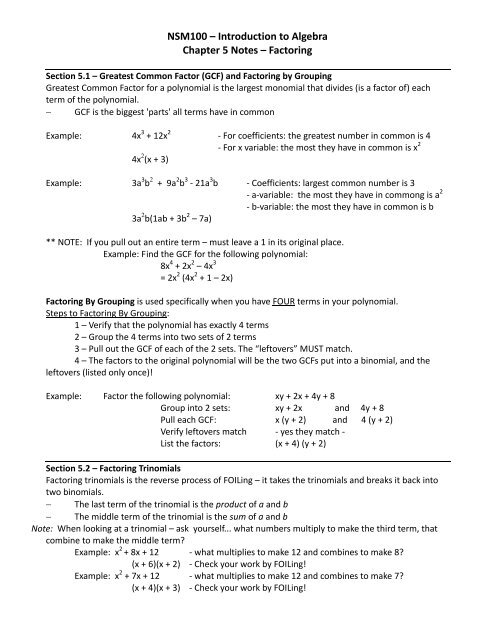
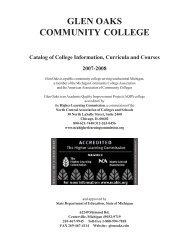

![Significant Figures Worksheet 1] Determine the number of significant ...](https://img.yumpu.com/50198655/1/190x245/significant-figures-worksheet-1-determine-the-number-of-significant-.jpg?quality=85)



